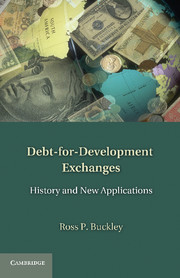Book contents
- Frontmatter
- Contents
- Acknowledgments
- List of Contributors
- Introduction: A Productive Partnership between Civil Society and the Academy
- Part I Types of Exchanges and Their Development over Time
- 1 The Early Years: The Evolution of a Technique
- 2 Debt-for-Nature Exchanges
- 3 Other Debt-for-Development Exchanges
- Part II Exchanges by Donor Countries
- Part III Critiques of Exchanges
- Part IV Innovative Applications of Exchanges
- Conclusion
- Index
- References
1 - The Early Years: The Evolution of a Technique
Published online by Cambridge University Press: 01 June 2011
- Frontmatter
- Contents
- Acknowledgments
- List of Contributors
- Introduction: A Productive Partnership between Civil Society and the Academy
- Part I Types of Exchanges and Their Development over Time
- 1 The Early Years: The Evolution of a Technique
- 2 Debt-for-Nature Exchanges
- 3 Other Debt-for-Development Exchanges
- Part II Exchanges by Donor Countries
- Part III Critiques of Exchanges
- Part IV Innovative Applications of Exchanges
- Conclusion
- Index
- References
Summary
INTRODUCTION
The beginning was the early 1980s. And in the beginning were bad loans, and from the loins of these bad loans sprang debt–equity exchanges, which quickly begat debt-for-nature exchanges, and then debt-for-education exchanges, and most recently, debt-for-health exchanges. And today, when all the begatting has been done, the progeny are known mostly as debt-for-development exchanges, or sometimes as debt-for-investment projects (by those who wish to suggest for the technique a more commercial focus).
The first debt-for-development exchange was undertaken in 1987. Two decades later, in 2007, it was estimated that these financial techniques had resulted in the cancellation of US$5.7 billion of debt and the application of US$3.6 billion to development projects. Early debt-for-development exchanges typically involved an environmental or other nongovernmental organisation (NGO), which purchased the debt for a discount in the secondary market and tendered it to the debtor government in return for a promise to apply an agreed-upon amount of local currency to mutually agreed-upon environmental or other projects in the debtor nation. The most common type of debt-for-development exchange today takes place directly between a creditor and debtor nation without NGO involvement. Under a typical exchange, the creditor nation will offer to cancel a specified part of a loan or loans if the debtor nation applies a portion of the amount cancelled (or perhaps the repayments it would have made on the loan over the next 5 to 10 years) towards mutually determined development projects in the debtor nation.
- Type
- Chapter
- Information
- Debt-for-Development ExchangesHistory and New Applications, pp. 9 - 16Publisher: Cambridge University PressPrint publication year: 2011
References
- 1
- Cited by



